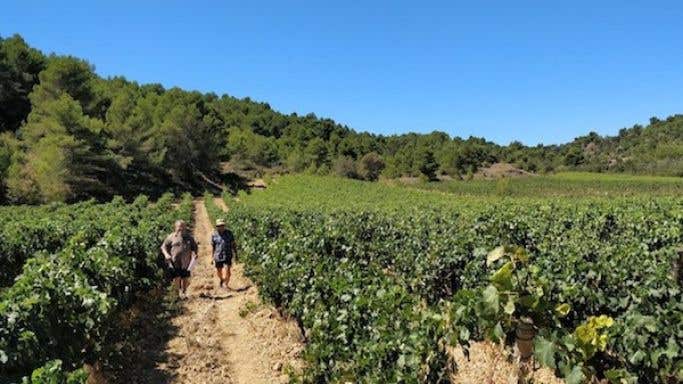Graham Nutter of Ch St-Jacques d'Albas in the western Minervois sends this vintage report form his bit of the Languedoc. In the picture the vines are inspected before the very early, very small harvest.
Every year is by definition full of surprises and we producers accept being at the mercy of Mother Nature. However, this year may have been the hardest in a long time on both the vines and the growers. France as a whole will have its lowest production in many years due to frost and drought, with the averages hiding some truly heart-rending stories of total loss. It was a double record year, for both the earliest harvest, as it seems our climate continues to change, and the smallest harvest in France since 1945.
For us in the Minervois, still reeling from a 40% drop in production last year, it started so positively...
Winter water
Winter was encouraging, with January to March witnessing some 340 mm (13.4 in) of rain, versus 152 mm for same period 2016. Also, January was cold but there were no frosts or hail of any note – and similarly for February. Pruning, that annual three- to four-month obligatory surgical labour, continued unabated, interrupted by some periods of continual rain, not a bad thing in the big picture.
The spring sprint
And then March announced a beautiful and somewhat early spring. Above-average temperatures, combined with the water-replenished soil, resulted in an explosion of growth, with weeds leading the charge. But given the sodden soil, we could not use our mechanical weed-cutters to hold their advance in check. Any visitor had problems seeing vines, especially among the younger plantings.
Were the vines holding something back for a late charge? Indeed, vine growth then spurted and budding burst. The balmy weather continued into April, allowing mechanical weeding and fertilisation (with organic goodies) to be completed. All highly promising for a recovery in yields, notably among the younger, shallower-rooted vines, after the drought-induced drops in 2016.
Frost bites
At the end of April disaster struck many vineyards throughout France, with a Siberian air mass rolling south, bringing sudden, plunging temperatures. There was little warning from the weather forecast and incredible images of vineyards desperately lighting fires along the rows of vines to stave off damage. St Jacques, fortunately, was only slightly affected, being higher than many surrounding vineyards. But it was a manifestation of the old saying that frost risk doesn’t disappear before May commences!
Summer scorcher
Having survived the frost, we experienced hot and dry summer months, and what little rain fell quickly evaporated on contact with the soil. Vines looked longingly at the swimming pool. June was particularly hot, but we vignerons were not too concerned, as we normally receive a few summer downpours (20–30 mm/0.8–1.2 in) of rain in July/August to give a boost to swelling of the grapes. But no! While some neighbours had some water dumps, our calls were ignored. Evidently, while budburst had been generous, the subsequent maturing of the grapes was constrained by an emerging summer drought! Plenty of grapes but all on minimum rations.
Vendange
Fast forward to late August. Analysis and tasting of the grapes gave mixed indications of when to harvest. Sugars on the whites suddenly developed in the third week of August – while acidities held firm. Tally-ho with the harvesting! This was a record early harvest for us, and the rest of France it seems, continuing a trend since we bought St Jacques d’Albas in 2001 (see graph of harvest start dates below).

There were small berries on the Viognier but compensatory juice on the Vermentino (Rolle), that drought-habitué variety from Sardinia. Grenache and Mourvèdre for the rosé came in at the end of August. Another story of plenty of small berries and juice yields down. Reds were picked from 7 September, led by the Grenache, then the Syrah, Mourvèdre and Carignan. The last-mentioned smiled all the way to the winery, a variety that basks in hot, dry conditions.
Our régisseur Marc had tears in his eyes when seeing the little volumes coming in, though we weren’t the only ones with plenty of grapes but low volumes. Some of our neighbours complained they were filling up their cuves with grapes, but having hardly any juice emerging. Just skins and pips!
The result
So, yet another year of low yields (40% less than normal) and a harvest a record two weeks earlier than expected. During fermentation, smiles returned to our faces as we tasted the evolving product. It is similar to 2003 but characterised by more maturity and higher acidities. This precocious vintage augurs well for quality but not abundance. Phenolic development appears better than 2016 too. The whites and rosé are improving all the time in tank – and are quite honestly a pleasant compensatory surprise. Reds are concentrated, sweet and seductive.
While lucky for not being severely damaged by the April frost, we are finding a second record year of low volumes is difficult to absorb. The quality is definitely there and we hope our vines are pushing their roots deeper for years to come. Roll on the rain this winter!
